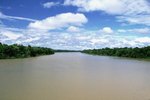
Volcanoes are responsible for the creation of many land masses across the globe. They act as vents that allow magma to escape from the Earth's core to the surface and are capable of vastly changing the surrounding landscapes. They also support many different forms of wildlife.
Locations of Volcanoes
There are two types of locations for volcanoes, and each offers a unique opportunity for wildlife of different types to thrive around them. Volcanoes can be either above ground or underwater, and they exist in many different forms. The underwater volcano locations provide an ideal environment aquatic life, while the areas surrounding the ground level volcanoes can lead to a thriving ecosystem of plants, mammals birds and insect species.
Underwater Volcano Ecosystems
Wildlife Extra's report on one large underwater volcano shows that many species have taken to a newly erupted volcano off the coast of Guam. The creatures have developed the ability to nourish themselves off the chemicals released by the eruption, and the populations continue to grow. The species include two kinds of shrimp (loihi, which were previously known from active Hawaii volcanoes, and another species that has yet to be named), limpets, barnacles and crabs.
These species all feed on the nutrients that come from the hardening lava, as well as the bodies of other sea creatures killed by the release of the poisonous gases. The unnamed shrimp species even attacks the loihi shrimp as a food source.
Surface-Level Volcano Ecosystems
Some plant types that thrive near volcanic eruption sites include coffee, grape vines, moss and the rare Hawaiian argyroxiphium, or "silversword." Plants use nutrients from the ash and cooled lava to flourish. Heavy rains make these plants reappear sooner after an eruption, which in turn brings other plant and animal species back to the area. The Hawaiian volcanic park areas, the Galapagos Islands and Mount St. Helens are ideal examples of this type of ecosystem, and good examples of areas that changed dramatically after a volcanic eruption.
Tropical Volcano Ecosystems
From crickets that need new lava flows to survive, to carnivorous caterpillars and exotic birds, Hawaii's volcanic areas are prime examples of the way that animals have evolved and adapted to their surroundings. There are 23 types of songbirds living on the Hawaiian islands, which means an ample supply of insects and flowers to satisfy their dietary needs. As a remote and somewhat isolated island location, the only animals that live there are the ones that were able to fly there initially -- animals like cats, rodents and domesticated creatures are considered invasive species.
Non-Tropical Volcano Ecosystems
In volcanic areas that are not on islands, the amount of wildlife is much more diverse. More types of animals are able to freely pass through and utilize the land, establishing populations. In the area surrounding Mount St. Helens, animals ranging from rabbits and mice to bobcats and bears thrive in the forests and flat lands. Animals are able to sense changes in the land around them, giving them ample time to retreat from the area when an eruption of any magnitude is imminent. This ability allows species to survive and adapt to any volcanic location.
References
- ThinkQuest: What is a Volcano
- Wildlife Extra: Unique and New species Thriving Around Erupting undersea Volcano
- Oregon State: How Do Volcanoes Affect Plants and Animals
- National Park Service: Hawaiian Volcanoes
- United States Department of Agriculture: Mt. Saint Helens National Volcanic Monument
- American Geophysical Union: Foliage vs. Geology: Plants on Volcanoes
Photo Credits
-
Ablestock.com/AbleStock.com/Getty Images




